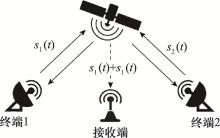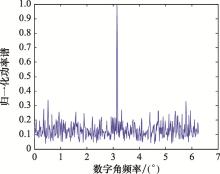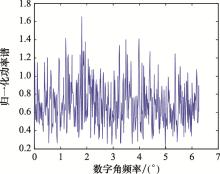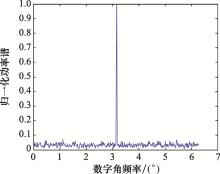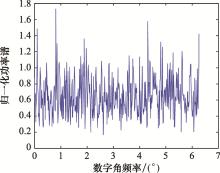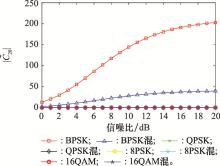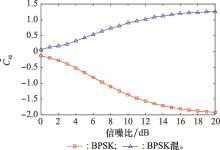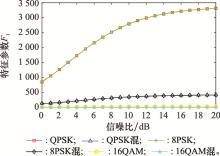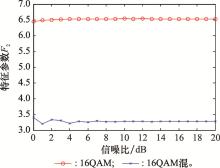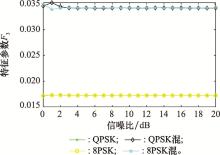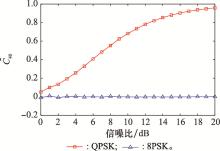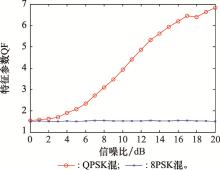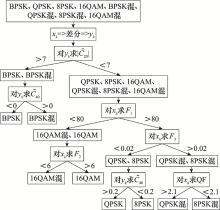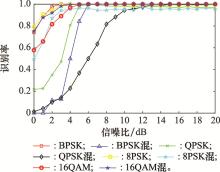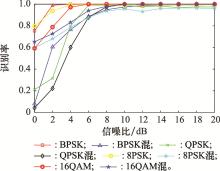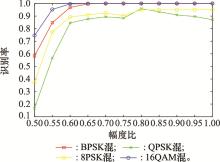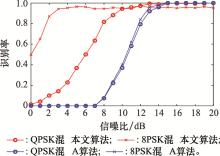Systems Engineering and Electronics ›› 2023, Vol. 45 ›› Issue (2): 589-596.doi: 10.12305/j.issn.1001-506X.2023.02.32
• Communications and Networks • Previous Articles
Modulation recognition for satellite single-mixed signals using joint characteristic parameters
Pei GONG, Tianyun LI, Xinliang ZHANG, Chentao CUN
- College of Information System Engineering, Information Engineering University, Zhengzhou 450001, China
-
Received:2021-09-26Online:2023-01-13Published:2023-02-04 -
Contact:Tianyun LI
CLC Number:
Cite this article
Pei GONG, Tianyun LI, Xinliang ZHANG, Chentao CUN. Modulation recognition for satellite single-mixed signals using joint characteristic parameters[J]. Systems Engineering and Electronics, 2023, 45(2): 589-596.
share this article
Table 1
Theoretical value of $\widetilde{C}_{p, q} $ of timed difference sequence yk"
| 调制方式 | |||||
| BPSK | 1 | 1 | -2 | -2 | 16 |
| QPSK | 0 | 1 | 1 | -1 | 4 |
| 8PSK | 0 | 1 | 0 | -1 | 4 |
| 16QAM | 0 | 0 | 0.4 | -0.27 | 0 |
| BPSK混 | 0.24 | 0.24 | 0.87 | 0.87 | -3.16 |
| QPSK混 | 0 | 0.25 | 0.23 | 0.26 | -0.5 |
| 8PSK混 | 0 | 0.25 | 0 | 0.3 | -0.5 |
| 16QAM混 | 0 | 0 | 0.12 | 0.75 | 0 |
| 1 | 彭闯, 杨晓静, 蔡晓霞. 卫星单-混信号识别研究[J]. 火力与指挥控制, 2019, 293 (8): 31- 35.31-35, 42 |
| PENG C , YANG X J , CAI X X . Research on satellite single-mixed signal recognition[J]. Fire Control and Command Control, 2019, 293 (8): 31- 35.31-35, 42 | |
| 2 | 郭一鸣. PCMA信号盲解调关键技术研究[D]. 郑州: 解放军信息工程大学, 2015. |
| GUO Y M. Research on key technology for blind demodulation of PCMA signal[D]. Zhengzhou: Information Engineering University, 2015. | |
| 3 | 刘少林. MPSK信号调制方式识别与参数估计[D]. 北京: 北京邮电大学, 2015. |
| LIU S L. Modulation mode identification and parameter estimation of MPSK signal[D]. Beijing: Beijing University of Posts and Telecommunications, 2015. | |
| 4 | 张玉静. 通信信号调制方式识别及参数估计[D]. 北京: 北京邮电大学, 2016. |
| ZHANG Y J. Modulation mode identification and parameter estimation of communication signal[D]. Beijing: Beijing University of Posts and Telecommunications, 2016. | |
| 5 | 王宇辉. 基于机器学习的数字调制识别技术研究[D]. 成都: 电子科技大学, 2020. |
| WANG Y H. Research on digital modulation recognition technology based on machine learning[D]. Chengdu: University of Electronic Science and Technology of China, 2020. | |
| 6 | 杨洁, 夏卉. 基于卷积神经网络的通信信号调制识别研究[J]. 计算机测量与控制, 2020, 28 (7): 220- 224. |
| YANG J , XIA H . Modulation recognition of communication signal based on convolutional neural network[J]. Computer Measurement and Control, 2020, 28 (7): 220- 224. | |
| 7 | 姚宇晨, 彭虎. 基于深度学习的通信信号自动调制识别技术[J]. 电子技术应用, 2019, 45 (2): 12- 15. |
| YAO Y C , PENG H . Automatic modulation recognition technology of communication signal based on deep learning[J]. Application of Electronic Technique, 2019, 45 (2): 12- 15. | |
| 8 |
张冬玲, 张君, 欧阳喜, 等. PCMA系统相位调制信号的谱特征分析[J]. 信息工程大学学报, 2011, 12 (2): 184- 187.184-187, 220
doi: 10.3969/j.issn.1671-0673.2011.02.012 |
|
ZHANG D L , ZHANG J , OUYANG X , et al. Spectrum characteristic analysis of phase modulation signal in PCMA system[J]. Journal of Information Engineering University, 2011, 12 (2): 184- 187.184-187, 220
doi: 10.3969/j.issn.1671-0673.2011.02.012 |
|
| 9 |
廖灿辉, 万坚, 周世东. 利用累积量和似然特征的卫星单-混信号调制识别算法[J]. 电讯技术, 2010, 50 (7): 44- 48.
doi: 10.3969/j.issn.1001-893x.2010.07.010 |
|
LIAO C H , WAN J , ZHOU S D . Modulation recognition algorithm of satellite single-mixed signal using cumulant and likelihood feature[J]. Telecommunication Engineering, 2010, 50 (7): 44- 48.
doi: 10.3969/j.issn.1001-893x.2010.07.010 |
|
| 10 | 金元盛, 戴旭初, 李辉. 一种有效的PCMA信号调制方式识别方法[J]. 遥测遥控, 2010, 31 (3): 12- 20. |
| JIN Y S , DAI X C , LI H . An effective PCMA signal modulation mode identification method[J]. Journal of Telemetry, Tracking and Command, 2010, 31 (3): 12- 20. | |
| 11 | 杨欣, 黄焱, 张冬玲, 等. 基于联合特征参数的PCMA信号调制识别算法[J]. 信息工程大学学报, 2013, 14 (1): 78- 83. |
| YANG X , HUANG Y , ZHANG D L , et al. Modulation recognition algorithm of PCMA signal based on joint characteristic parameters[J]. Journal of Information Engineering University, 2013, 14 (1): 78- 83. | |
| 12 | 付迪, 高勇. 非对称PCMA卫星信号的截获方法[J]. 现代电子技术, 2007, 30 (7): 28- 30.28-30, 34 |
| FU D , GAO Y . Interception method of asymmetric PCMA satellite signal[J]. Modern Electronic Technology, 2007, 30 (7): 28- 30.28-30, 34 | |
| 13 | 贾子欣, 陈卫东, 杨松. PCMA信号调制识别研究[J]. 电子测量技术, 2020, 43 (20): 133- 138. |
| JIA Z X , CHEN W D , YANG S . Research on modulation recognition of PCMA signal[J]. Electronic Measurement Technology, 2020, 43 (20): 133- 138. | |
| 14 | MORELLI M , D'ANDRE A N , MENGALI U . Feedforward ML-based timing estimation with PSK signals[J]. IEEE Communications Letters, 2002, 1 (3): 80- 82. |
| 15 | MUSTAFA H, DOROSLOVACKI M. Effect of carrier offset on the classification of phase shift keying modulation using the subtraction of two consecutive signal values[C]//Proc. of the IEEE International Conference on Acoustics, Speech and Signal Processing, 2007: 1289-1292. |
| 16 | SWAMI A , SADLER B M . Hierarchical digital modulation classification using cumulants[J]. IEEE Trans.on Communications, 2000, 48 (3): 416- 429. |
| 17 | 赵雄文, 郭春霞, 李景春. 基于高阶累积量和循环谱的信号调制方式混合识别算法[J]. 电子与信息学报, 2016, 38 (3): 674- 680. |
| ZHAO X W , GUO C X , LI J C . Hybrid recognition algorithm of signal modulation mode based on high order cumulant and cyclic spectrum[J]. Journal of Electronics & Information Technology, 2016, 38 (3): 674- 680. | |
| 18 | 谭晓衡, 褚国星, 张雪静, 等. 基于高阶累积量和小波变换的调制识别算法[J]. 系统工程与电子技术, 2018, 40 (1): 176- 182. |
| TAN X H , CHU G X , ZHANG X J , et al. Modulation recognition algorithm based on high order cumulant and wavelet transform[J]. Systems Engineering and Electronics, 2018, 40 (1): 176- 182. |
| [1] | Hongping ZHOU, Minghui MA, Ruowu WU, Xiong XU, Zhongyi GUO. Deception jamming recognition of radar based on sparse representation classification [J]. Systems Engineering and Electronics, 2022, 44(9): 2791-2799. |
| [2] | Jialei LIU, Jiazhi MA, Longfei SHI. DOA estimation algorithm based on fourth-order cumulant using virtual beam forming [J]. Systems Engineering and Electronics, 2022, 44(7): 2134-2142. |
| [3] | Bowei QIN, Lei JIANG, Hua XU, Zisen QI. Modulation recognition algorithm based on residual generation adversarial network [J]. Systems Engineering and Electronics, 2022, 44(6): 2019-2026. |
| [4] | Kai SHAO, Miaomiao ZHU, Guangyu WANG. Modulation recognition method based on generative adversarial andconvolutional neural network [J]. Systems Engineering and Electronics, 2022, 44(3): 1036-1043. |
| [5] | Yunhao SHI, Hua XU, Wanze ZHENG, Yinghui LIU. Few-shot modulation recognition method based on ensemble learning and feature dimension reduction [J]. Systems Engineering and Electronics, 2021, 43(4): 1099-1109. |
| [6] | Zihao SONG, Wei CHENG, Cenxin PENG, Xiaobai LI. Modulation recognition method based on CWD and residual shrinkage network [J]. Systems Engineering and Electronics, 2021, 43(11): 3371-3379. |
| [7] | Kai LIU, Bin ZHANG, Qinghua HUANG. Modulation recognition algorithm based on TCNN-BiLSTM [J]. Systems Engineering and Electronics, 2020, 42(8): 1841-1849. |
| [8] | Kai LIU, Mengwei ZHAO, Qinghua HUANG. Multi-h CPM modulation recognition algorithm based on approximate entropy [J]. Systems Engineering and Electronics, 2020, 42(3): 698-703. |
| [9] | Chen LI, Jun'an YANG, Hui LIU. Modulation recognition algorithm based on information entropy and GA-ELM [J]. Systems Engineering and Electronics, 2020, 42(1): 223-229. |
| [10] | YUAN Lifen, NING Shuguang, HE Yigang, LYU Mi, LU Jian. Modulation recognition method based on high-order cumulant feature learning [J]. Systems Engineering and Electronics, 2019, 41(9): 2122-2131. |
| [11] | MAO Hu, WU Dewei, LIU Haibo, LU Hu, LI Zhonghua. GPS military signal monitoring and parameter estimation method [J]. Systems Engineering and Electronics, 2019, 41(11): 2431-2438. |
| [12] | XU Zhenyang, ZHANG Jingyuan, WANG Peng. Selection of matching routes in terrain aided navigation [J]. Systems Engineering and Electronics, 2019, 41(11): 2588-2596. |
| [13] | HAO Yunfei, LIU Zhangmeng, GUO Fucheng, ZHANG Min. Open-set recognition of signal modulation based on generative adversarial networks [J]. Systems Engineering and Electronics, 2019, 41(11): 2619-2624. |
| [14] | QI Dong, TANG Min, LIU Chengcheng, ZHAO Yongjun. Two-dimensional DOA estimation method for mixed signals under Gaussian color noise [J]. Systems Engineering and Electronics, 2019, 41(10): 2198-2204. |
| [15] | TAN Xiaoheng, CHU Guoxing, ZHANG Xuejing, YANG Yang. Modulation recognition algorithm based on high-order cumulants and wavelet transform [J]. Systems Engineering and Electronics, 2018, 40(1): 171-177. |
| Viewed | ||||||
|
Full text |
|
|||||
|
Abstract |
|
|||||
